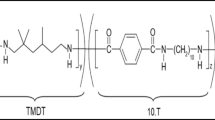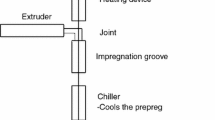Abstract
Long and short glass fibers (GF) were incorporated into the polyamide 6,6 (PA66)/polypropylene (PP) mixtures in order to enhance the thermomechanical properties. The effect of fiber length and processing procedures on tensile strength, flexural modulus, impact strength, and heat deflection temperature has been investigated. Miscibility behavior of the PA66/PP mixtures has been examined by performing differential scanning calorimetry analysis and theoretical calculation. The mixtures exhibiting broad coexistent regions such as crystal + crystal (Cr1 + Cr2), crystal + liquid (Cr1 + L2), and liquid + crystal (L1 + Cr2) revealed a significant improvement in thermal and mechanical properties by the addition of GF. Especially, long fiber-reinforced thermoplastics showed better performances compared to short fiber-reinforced thermoplastics at the same filler loading. From the morphological observation of the fractured surface, it was realized that the incorporation of long GF after the melt blending of PA66 and PP was very effective to attain high thermomechanical properties due to the better homogeneity and compatibility.











Similar content being viewed by others

References
González-Montiel A, Keskkula H, Paul DR (1995) Impact-modified nylon 6/polypropylene blends: 1. morphology-property relationships. Polymer 36:4587–4603
Sacchi A, Di Landro L, Pegoraro M, Severini F (2004) Morphology of isotactic polypropylene–polyamide 66 blends and their mechanical properties. Eur Polym J 40:1705–1713
Van Gheluwe P, Favis BD, Chalifoux JP (1988) Morphological and mechanical properties of extruded polypropylene/nylon-6 blends. J Mater Sci 23:3910–3920. doi:10.1007/BF01106813
**aomin Z, Gang L, Dongmei W, Zhihui Y, **ghua Y, **gshu L (1998) Morphological studies of polyamide 1010/polypropylene blends. Polymer 39:15–22
Ohlsson B, Hassander H, Törnell B (1998) Improved compatibility between polyamide and polypropylene by the use of maleic anhydride grafted SEBS. Polymer 39:6705–6714
Majumdar B, Paul DR, Oshinski AJ (1997) Evolution of morphology in compatibilized vs uncompatibilized polyamide blends. Polymer 38:1787–1808
Menyhárd A, Varga J (2006) Effect of compatibilizers on the crystallization, melting and polymorphic composition of β-nucleated isotactic polypropylene and polyamide 6 blends. Eur Polym J 42:3257–3268
Guo R, Li J, Yan LT, **e XM (2013) Role of compatibilizer in multicomponent polymer mixtures under shear flow. Soft Matter 9:255–260
Zhu J, He Q, Luo Z, Khasanov A, Li Y, Sun L, Wang Q, Wei S, Guo Z (2012) Property manipulated polypropylene–iron nanocomposites with maleic anhydride polypropylene. J Mater Chem 22:15928–15938
Spencer MW, Cui L, Yoo Y, Paul DR (2010) Morphology and properties of nanocomposites based on HDPE/HDPE-g-MA blends. Polymer 51:1056–1070
Inoue Y, Matsugi T, Kashiwa N, Matyjaszewski K (2004) Graft copolymers from linear polyethylene via atom transfer radical polymerization. Macromolecules 37:3651–3658
Utsel S, Bruce C, Pettersson T, Fogelstrom L, Carlmark A, Malmstrom E, Wagberg L (2012) Physical tuning of cellulose-polymer interactions utilizing cationic block copolymers based on PCL and quaternized PDMAEMA. ACS Appl Mater Interfaces 4:6796–6807
Hsiao MC, Laio SH, Lin YF, Weng CC, Tsai HM, Ma CCM, Lee SH, Yen MY, Liu PI (2011) Polypropylene-grafted multi-walled carbon nanotube reinforced polypropylene composite bipolar plates in polymer electrolyte membrane fuel cells. Energy Environ Sci 4:543–550
Kim KT, Jo WH (2009) Synthesis of poly(3-hexylthiophene)-graft-poly(t-butyl acrylate-co-acrylic acid) and its role of compatibilizer for enhancement of mechanical and electrical properties of nylon 66/multi-walled carbon nanotube composites. Comput Sci Technol 69:2205–2211
Hambir R, Bulakh N, Jog JP (2002) Polypropylene/clay nanocomposites: effect of compatibilizer on the thermal, crystallization and dynamic mechanical behavior. Polym Eng Sci 42:1800–1807
García-López D, Picazo O, Merino JC, Pastor JM (2003) Polypropylene–clay nanocomposites: effect of compatibilizing agents on clay dispersion. Eur Polym J 39:945–950
Harmia T, Friedrich K (1995) Fracture toughness and failure mechanisms in unreinforced and long-glass-fibre-reinforced PA66/PP blends. Compos Sci Technol 53:423–430
Thomason JL (2009) The influence of fibre length, diameter and concentration on the impact performance of long glass-fibre reinforced polyamide 6,6. Compos Part A 40:114–124
Thomason JL (2002) The influence of fibre length and concentration on the properties of glass fibre reinforced polypropylene: 5. Injection moulded long and short fibre PP. Compos Part A 33:1641–1652
Thomasset J, Carreau PJ, Sanschagrin B, Ausias G (2005) Rheological properties of long glass fiber filled polypropylene. J Non Newtonian Fluid Mech 125:25–34
Flory PJ (1942) Thermodynamics of high polymer solutions. J Chem Phys 10:51–61
Huggins ML (1942) Theory of solutions of high polymers. J Am Chem Soc 64:1712–1719
Kobayashi R (1993) Modeling and numerical simulations of dendritic crystal growth. Physica D 63:410–423
Matkar RA, Kyu T (2006) Phase diagrams of binary crystalline–crystalline polymer blends. J Phys Chem B 110:16059–16065
Matkar RA, Kyu T (2006) Role of crystal–amorphous interaction in phase equilibria of crystal–amorphous polymer blends. J Phys Chem B 110:12728–12732
Koningsveld R, Stockmayer WH, Nies E (2001) Polymer phase diagram a textbook. Oxford University, New York, pp 3–44
Thomason JL, Vlug MA (1997) Influence of fibre length and concentration on the properties of glass fibre-reinforced polypropylene: 4. Impact properties. Compos Part A 28A:277–288
Acknowledgements
This research was mainly supported by GS Caltex Co., Converging Research Center Program (2012K001428), and BK21 Plus Program, Korea. Dae-Yoon Kim appreciates the support from Global Ph.D. Fellowship Program (NRF-2013H1A2A1033907).
Author information
Authors and Affiliations
Corresponding author
Rights and permissions
About this article
Cite this article
Kim, N., Kim, DY., Kim, YJ. et al. Enhanced thermomechanical properties of long and short glass fiber-reinforced polyamide 6,6/polypropylene mixtures by tuning the processing procedures. J Mater Sci 49, 6333–6342 (2014). https://doi.org/10.1007/s10853-014-8358-1
Received:
Accepted:
Published:
Issue Date:
DOI: https://doi.org/10.1007/s10853-014-8358-1



